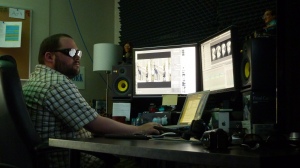Editing a 3D Documentary: Review of Panasonic’s 25” BT-3DL 2550
If you want to create a high-quality 3D program, having the best-of-the-best in production equipment is a must – that and a great crew, of course.
So while we’ve been in post-production for our first 3D documentary, our editor Brian Mann and I have been on the hunt for a picture-perfect 3D monitor to QC our cuts.
The latest contender: Panasonic’s 25” BT-3DL 2550, a passive circular-polarized monitor with dual processors.
The Panasonic comes with all the bells and whistles any 3D editor could ask for: pro-connectors, 10 bit 3D LUT for great color accuracy, 3 stereo viewing options including simultaneous, line-by-line, and side-by-side.
But when we brought it in to try it out we ran into an unexpected problem – the display’s polarizing filter wouldn’t work properly with our RealD glasses. The colour was off – pink tinges galore.
Funny thing was when we turned our 3D glasses sideways it seemed to work. Hmmmm.
We’re not sure whether it’s a proprietary or technology issue. The Panasonic tech support team wasn’t sure either.
So in the end, we chose to send the Panasonic back.
We weren’t up to buying another set of 3D glasses on top of the ones we already had. Panasonic charges $100 per set which, along with the pricier monitor—Panasonic $10 000 vs. JVC $6 600 —is a bit hard to swallow.
We’ll nail down a dual stream monitor soon enough. It’s just going to take a little more digging.
–Ian Herring, President




